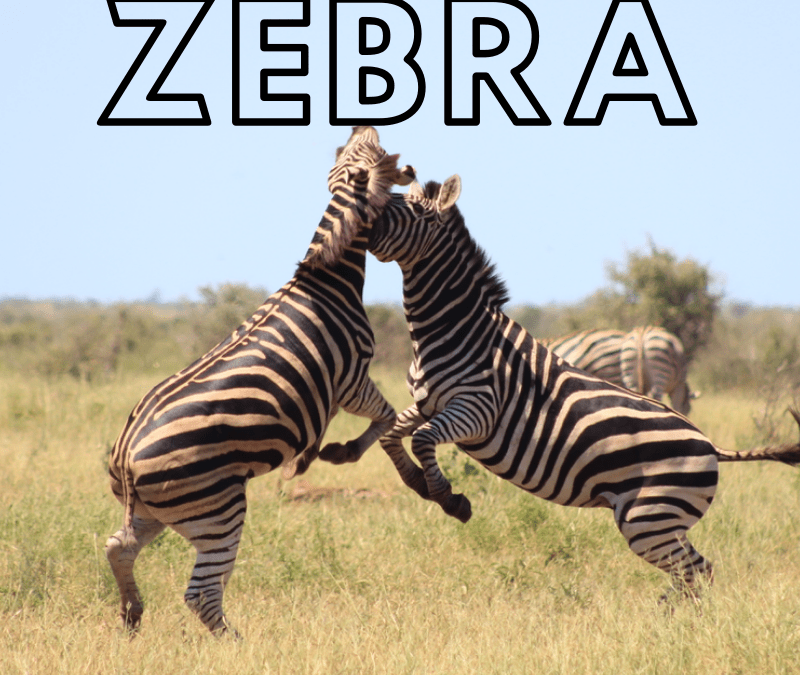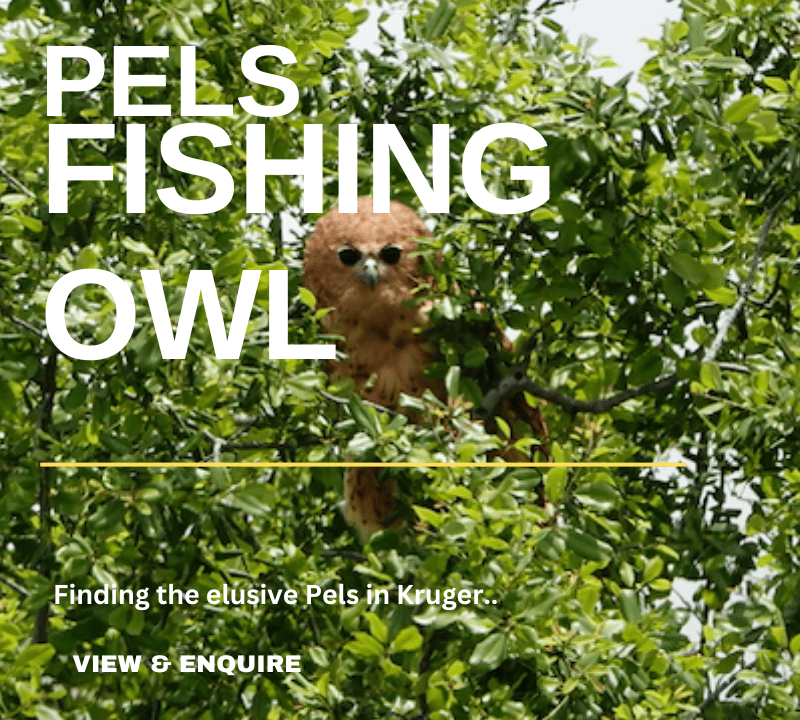
The Plains Zebra
(Equus quagga)
Origin of the word “Zebra”
The word comes from Old Portuguese which was spoken off the east coast of Southern Africa. Pronounced “zevra” the word is believed to translate to “wild ass”. There is a lot of sense as Zebra are members of the equine family and do have that characteristic stubborn trait.
Family : Equidae
Collective noun : dazzle, zeal, cohort
Weight : 290kg – 340kg (male and female very similar in weight with little dimorphism)
Shoulder height : +-130cm
Number of teats : 2 inguinal
Gestation : 12 months
The only species of Zebra we find in the Kruger National Park, the Plains Zebra, live in family groups of up to 12 mares, their young foals and the dominant stallion. Stallions that don’t have a mares will joining together forming bachelor party’s or live alone. Where there is an abundance of good grazing available you can find hundreds of Zebra coming together with each herd staying independent bar the occasional scrap that the dominant stallion endures to protect his females and prevent them being stolen. Plains Zebra occupy a loosely organised home range that offers optimal grazing and water. Dependant on their regional location and distribution they may migrate seasonally to better areas following the rains.
The Zebra Stripe
Quite possibly the most conspicuous herbivore in the savanna, the Zebra’s unique strip pattern and colouration has long been a source of interest and intrigue. The purpose of these stripes has stimulated a great deal of discussion and led to various creative theories. Here are a few that seemingly may have some rationale and effect :
- The Stripes are for temperature control – what this suggests is that as the black stripe attracts heat with large capillaries to disperse the warmth during the cooler mornings and night, the white stripe effectively dispels during the hotter periods of the day. The reality is however that we have witnessed these animals out in the savanna with other species and seemingly don’t see how the stripes are comparatively used as temperature control when you consider all the others don’t have them and also cope.
- The Stripes successfully repel parasites – of course Zebra are not immune to any or all of the typical blood sucking parasites found in the savanna. Experiments done revealed that a black and white striped barn door attracted far less tsetse fly activity than any other colour but the reality is that Tsetse fly live in woodland savanna and not grassland savanna.
- The Stripes could possibly offer a disruptive form of camouflage – this idea suggests that the black and white stripe are effective in removing profile and is able to disrupt form to confuse potential predators when trying to select an individual in a herd. If you take into account that predators can only see in Rods (black, white and light) and you take an image of several Zebra together in black and white, their dazzling display certainly does remove profile and the scene appears confusing. BUT, the question is, is it the result of the stripes or rather their habit of coming together and being attracted to each other because of the stripes. This then asks the question if the Zebra stripe is rather a personal attraction and they themselves are drawn to each other in moments of stress and the resulting effect is just an outcome of their niche design.
Zebra Behaviour
Zebra are social, grazing herbivores that remain in constant contact with fellow herd members. A family herd consists of a single dominant adult stallion with up to 6 mares of which the oldest is usually the most dominant female. Young stallions that come into sexual maturity will leave their natal herd around 3 to 4 years of age joining a bachelor herd. These bachelor herds are usually unstable as each stallion matures and they all continue to compete for dominance. The bachelors will live on the periphery of a female herd and these males will compete against the dominant herd stallion. The strongest stallion will always rule and this ensuring the best genetics within each herd.
Zebra stallions will fight aggressively amongst each other inflicting severe injuries. Mock fighting is common and is based on a test of strength and confidence but can often erupt into higher levels of aggression with serious injuries from biting and kicking. Its not uncommon to find stallions with half a tail, only one ear and mis-aligned stripes that have heeled from a old gash along the flanks.
Zebras like to greet each other by continuously opening and closing their mouths and raising their top lips with ears facing forward. Gentle playful bites are also seen but this can change quickly and particularly amongst Stallions. This behaviour is similar but the ears cock backward with the jaw and head slightly raised. A submissive Zebra will rather lower its head, have its ears forwards or sideways and exhibit and chewing behaviour rather than lifting its lip to show its incisors. What many people don’t realise is just how aggressive a Stallion can be, showing signs of aggression that would even intimidate a Lion. Whilst herding his females a dominant stallions will move boldly around the herd, head lowered and ears back. He moves with speed and intention and is ready to rear, kick and bite at the show of any resistance. Zebras will make high pitch squeals when threatening to attack and the mares will whine to call their foals. When engaged in a full scale fight, herd stallions will first approach very slowly, touching noses, testing strength by laterally pushing and rubbing against each other. In a full-scale breakout of aggression, stallions will rear up, bite and kick with going for knees, flanks, rumps, ears and tails. The effects of these aggressive encounters is noticeable with many a stallion reduce to one ear, half a tail and impressive gashes on the hind quarters.
Zebra Habitat
Zebra prefer wide open grasslands with scattered trees. They are a migrating species that will follow the grasses seasonally. Zebra are not found in deserts, forrest and try to avoid rocky uneven terrain that includes hills, slopes etc.
Diet
Zebra are hind-gut fermentors meaning they do not have a four chambered stomach and do not “chew the cud”. They have a single stomach with an advanced caecum that acts as a vat of microbial’s and acids. Zebra favour the grasses and are classified as grazers but are regarded to take 5% browse in their diet. They are adaptable grazers and will take all levels of grass but seemingly do prefer the higher upper parts of the grass stalk at a height of 35 – 50cm. With a large and mobile upper lip they are able to use it to remove grass that get stuck in their teeth. They have a sharp row of incisors for cropping grasses followed by the characters equine “diastema” which is the space between the incisors and the back row of pre-molar/molar which is for grinding. As a result of the species being hind-gut fermentors they are unable to masticate their fodder to the same degree as ruminants and as such are required to consume far more than their counter parts. This can be seen in their longer grazing periods, which can take up to 15 hours of their day as well as their rougher and less digested dung.
Scientists have also established that Zebra have thousands of parasites that colonise their bowels. Some 37 different species have been identified which feed on food in the Zebra’s digestive system and when they die are consumed as a protein back into the body. Many of these parasites and bacterias also play a role within the bowel to facilitate digestion and for this reason young Zebra foals will consume their mothers dung to colonise and propagate these parasites and bacteria in their own bowel.
Zebra are dependant on water as a result of all the fibre they consume and will be found within 6 to 10km of water. Zebra are dependant on clean drinking water and will drink twice a day, usually around mid-morning and then again at dusk consuming 6 to 8 litres of water per day. Zebra have been documented to use there front hooves to scrape depressions in dry river beds in search of clean drinking water.
Why do Zebras walk nodding their heads ?
Zebra are constantly harassed by the Botfly, which lay their eggs so surrounding dermis of the knees and front legs, throat as well as nostrils and nasal aperture, eye lining and mouth. Eggs are hatched through temperature contact with the host and then emerge as maggots (bots) which begin to feed on the softer linings of skin. To try and rid themselves of these parasites Zebra will snort through their nose, lifting their heads up and down to try and rid the maggots. Zebra will also shiver and shake their hide in waves to try and prevent flies from landing as well as shake off irritating maggots.
Inserting Zebra Facts :
- Zebra can run of speeds between 60 and 70 km/ph.
- Mares give birth to foals lying down with the dominant stallion watching over her.
- The Swahili word for Zebra is Punda and gives reference to the far northern Kruger Camp Punda Maria.
- The life expectancy of a Zebra is approximately 30 years.
- Zebra foals are a favorite prey of Lions.
- The Kruger National Park Zebra population is around 35,000 (2018)





